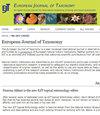标题印度蚁蜂属二新种(膜翅目:蚁科)及五新记录
IF 1.3
3区 生物学
Q3 ENTOMOLOGY
引用次数: 0
摘要
本文描述了印度的两个新种,即11月的坎波诺塔斯·斯霍勒斯(Camponotus sholensis)和11月的坎波诺塔斯·梅加拉亚(Camponotus meghalayaensis),并重新描述了印度的四个新种(C. habereri Forel, 1911年,C. keihitoi Forel, 1913年,C. quadrinotatus Forel, 1886年和C. simoni Emery, 1893年)。我们还记录并描述了一种身份不明的“Camponotus sp. 101”,它与印度已知的任何物种都不对应。还提供了附有该属已知种的数字图像的识别密钥。本文章由计算机程序翻译,如有差异,请以英文原文为准。
Two new species of the genus Camponotus Mayr, 1861 (Hymenoptera: Formicidae) with five new records from India
Two new species, Camponotus sholensis sp. nov. and Camponotus meghalayaensis sp. nov. are described from India and redescriptions of four species (C. habereri Forel, 1911, C. keihitoi Forel, 1913, C. quadrinotatus Forel, 1886 and C. simoni Emery, 1893) new to India are provided. We also recorded and described an unidentified form ‘Camponotus sp. 101’ that does not correspond to any species already known in India. An identification key supplemented with digital images of the known species of the genus is also provided.
求助全文
通过发布文献求助,成功后即可免费获取论文全文。
去求助
来源期刊

European journal of taxonomy
ZOOLOGY-
CiteScore
2.30
自引率
8.30%
发文量
173
审稿时长
29 weeks
期刊介绍:
EJT is a fully refereed, international, fully electronic Open Access journal in descriptive taxonomy, covering subjects in zoology, entomology, botany (in its broadest sense), and palaeontology. EJT-papers must be original and adhere to high scientific (content) and technical (language, artwork, etc.) standards. Manuscripts that are clearly substandard in either of these categories will not be sent out for review. EJT is supported by a consortium of European Natural History Institutes, but its scope is global. Both authorship and geographical region of study need not be European. Authors are, however, strongly encouraged to involve European Natural History collections by consulting material or by depositing specimens (e.g. types and figured material) related to their published paper in the collection of a European Natural History Institute.
 求助内容:
求助内容: 应助结果提醒方式:
应助结果提醒方式:


